fuel CHEVROLET CAMARO 1996 4.G Owners Manual
[x] Cancel search | Manufacturer: CHEVROLET, Model Year: 1996, Model line: CAMARO, Model: CHEVROLET CAMARO 1996 4.GPages: 402, PDF Size: 21.38 MB
Page 6 of 402
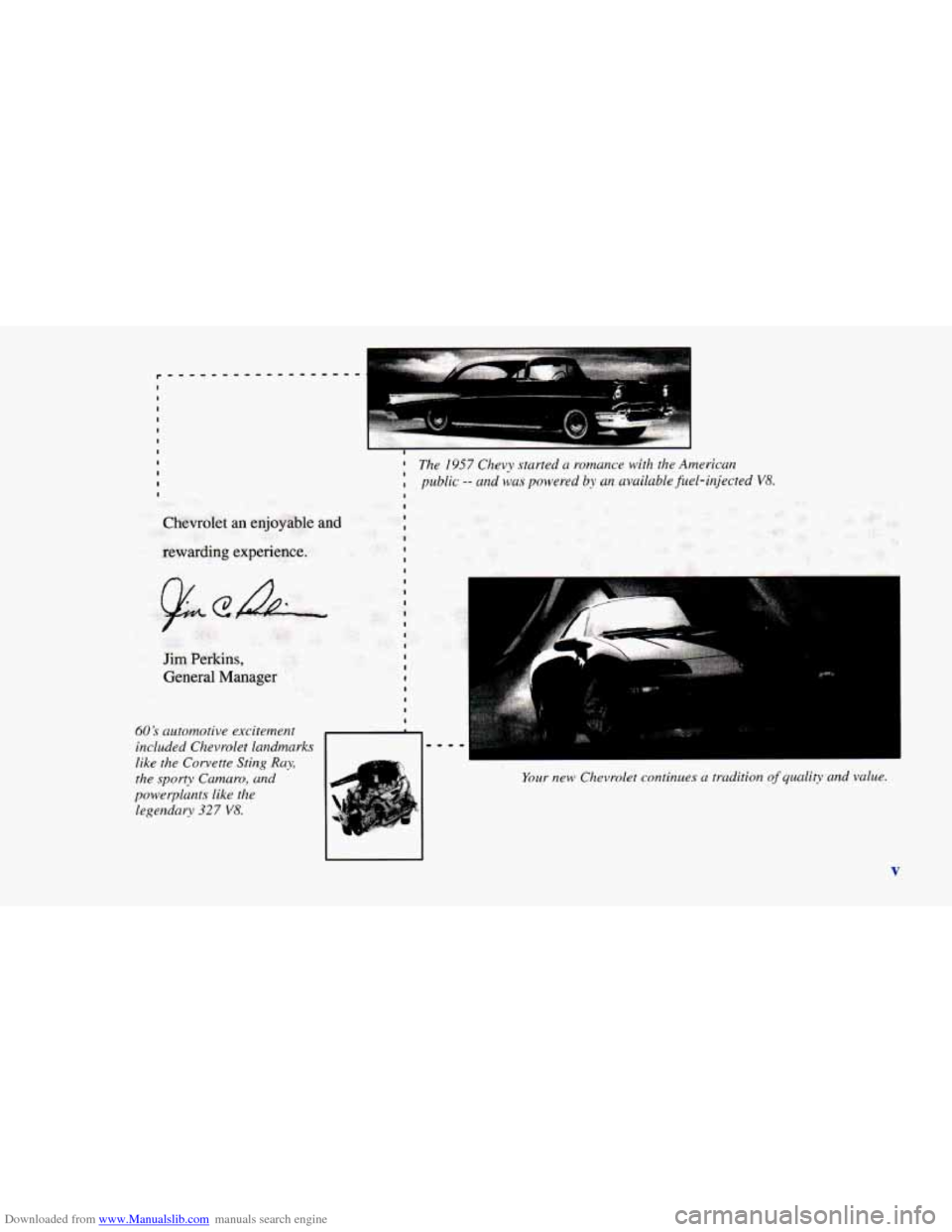
Downloaded from www.Manualslib.com manuals search engine I I
I t I I
Chevrolet an enjoyable and
rewarding experience. I I
I
The 1951 Chevy started a romance with the American
public
-- und was powered by un available fuel-injected V8
t
Jim Perkins,
General Manager I I I I I
I
I
60 S automotive excitement ,-
included Chevrolet landmarks I
like the Corvette Sting Ray,
the sporty Camuro, and
powerplants like the legendary
327 V8.
V
Page 9 of 402
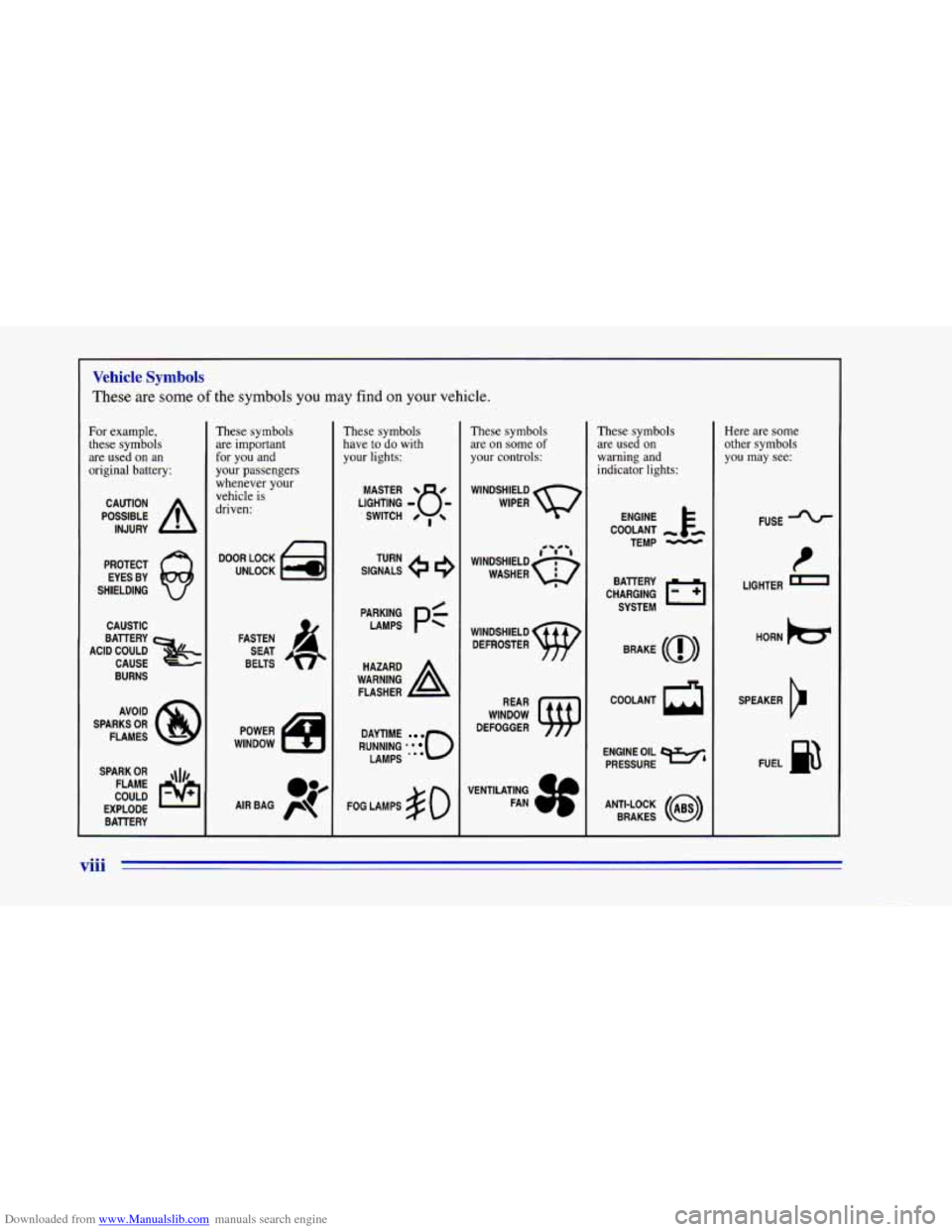
Downloaded from www.Manualslib.com manuals search engine Vehicle Symbols
These are some of the symbols you may find on your vehicle.
For example,
these symbols
are used on an
original battery:
POSSIBLE A
CAUTION
INJURY
PROTECT EYES BY
SHIELDING
Q
CAUSTIC
ACID COULD BATTERY
CAUSE
BURNS
SPARK
OR ,\I/,
COULD FLAME
EXPLODE BATTERY
These symbols
are important
for you and
your passengers
whenever your
vehicle
is
driven:
DOOR LOCK
UNLOCK
FASTEN SEAT
BELTS
These symbols
have to do with
your lights:
SIGNALS e 9
TURN
RUNNING
' ' 0
DAYTIME a
LAMPS
FOG LAMPS
$0
These symbols
are on some
of
your controls:
WIPER w
WINDSHIELD
DEFROSTER
VENTILATING FAN
These symbols are
used on
warning and
indicator lights:
COOLANT -
TEMP -
CHARGING I-1
BATTERY
SYSTEM
BRAKE
(a)
COOLANT a
ENGINE OIL e,
PRESSURE
ANTI-LOCK
(a)
BRAKES
Here are some
other symbols
you may see:
FUSE -%-
LIGHTER n
HORN k3
SPEAKER
b
FUEL p3
viii
Page 44 of 402
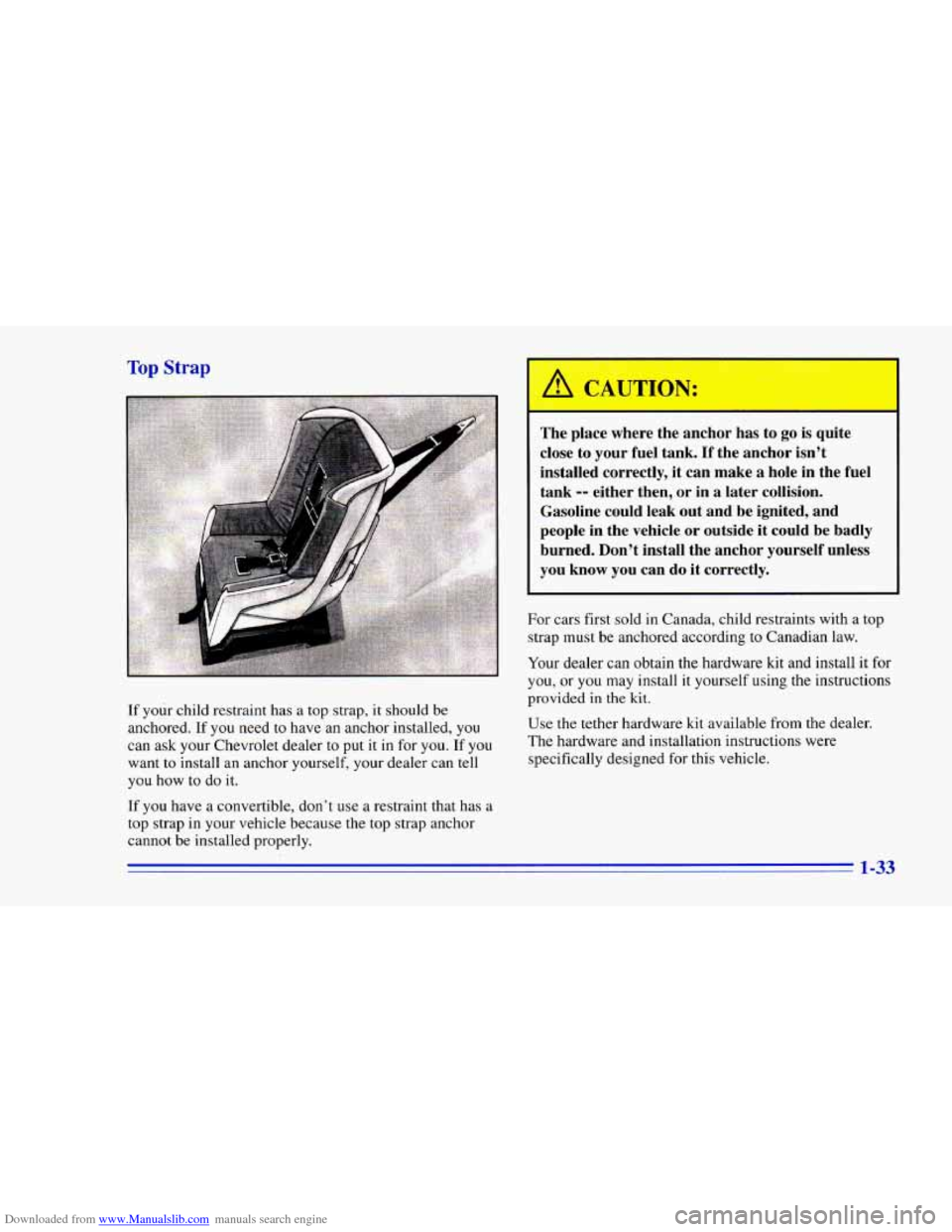
Downloaded from www.Manualslib.com manuals search engine Top Strap
If your child restraint has a top strap, it should be
anchored.
If you need to have an anchor installed, you
can ask your Chevrolet dealer to put
it in for you. If you
want to install an anchor yourself, your dealer can
tell
you how to do it.
If you have a convertible, don’t use a restraint that has a
top strap in your vehicle because the top strap anchor
cannot be installed properly.
The place where the anchor has to go is quite
close to your fuel tank.
If the anchor isn’t
installed correctly, it can make
a hole in the fuel
tank
-- either then, or in a later collision.
Gasoline could leak
out and be ignited, and
people in the vehicle or outside it could be badly
burned. Don’t install the anchor yourself unless
you
know you can do it correctly.
For cars first sold in Canada, child restraints with a top
strap must be anchored according
to Canadian law.
Your dealer can obtain the hardware kit and install it for
you, or you may install it yourself using the instructions
provided in the kit.
Use the tether hardware kit available from the dealer.
The hardware and installation instructions were
specifically designed
for this vehicle.
1-33
Page 71 of 402
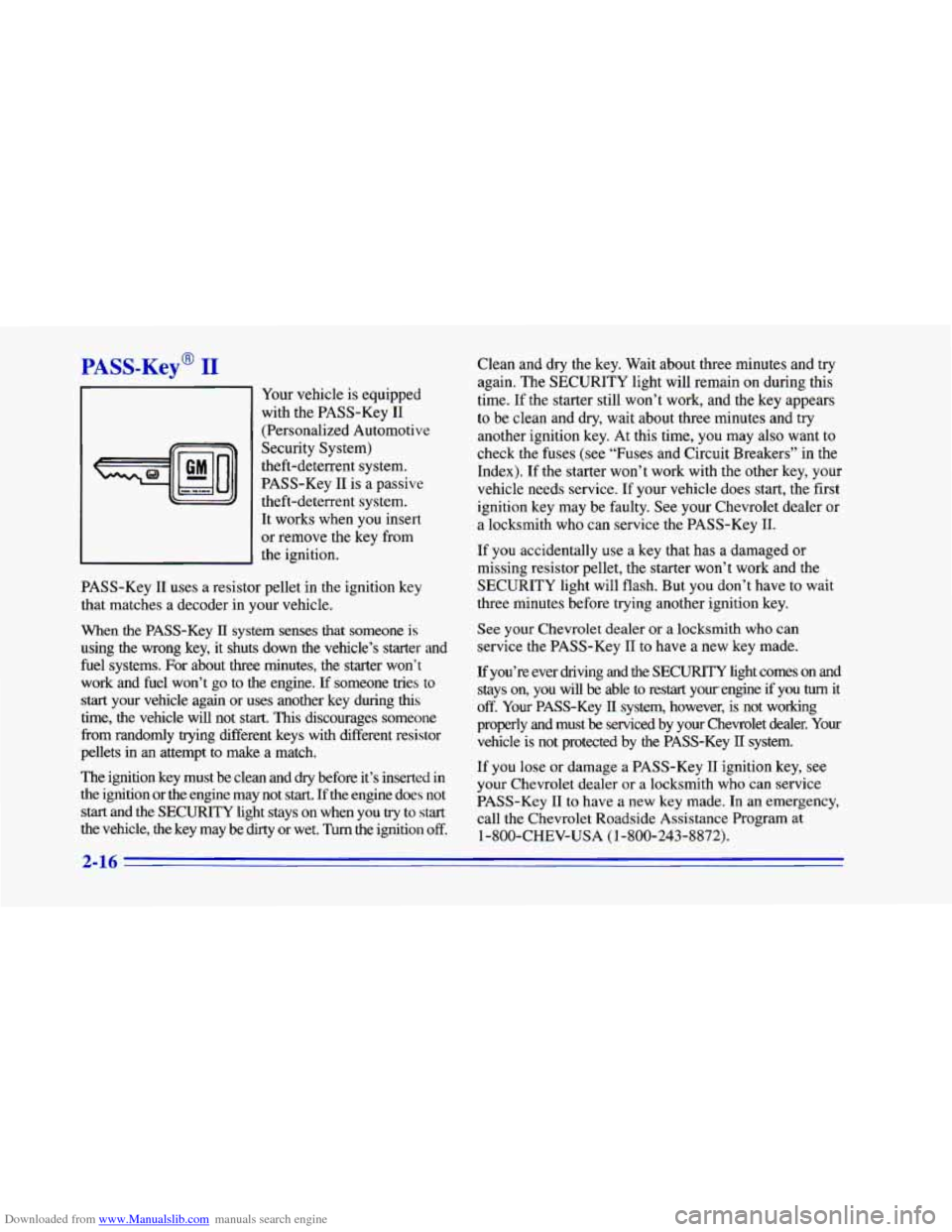
Downloaded from www.Manualslib.com manuals search engine PASS-Key@ I1
Your vehicle is equipped
with the PASS-Key
I1
(Personalized Automotive
Security System)
theft-deterrent system.
PASS-Key
I1 is a passive
theft-deterrent system.
It works when
you insert
or remove the key from
the ignition.
PASS-Key
I1 uses a resistor pellet in the ignition key
that matches a decoder in your vehicle.
When the PASS-Key
TI system senses that someone is
using the wrong key, it shuts down the vehicle’s starter and
fuel systems.
For about three minutes, the starter won’t
work and fuel won’t go to the engine.
If someone tries to
start your vehicle again or uses another key during this
time, the vehicle will not start.
This discourages someone
from randomly trying different keys with different resistor
pellets in an attempt to make a match.
The ignition key must be clean and
dry before it’s inserted in
the ignition or
the engine may not start. If the engine does not
start and the SECURITY light stays on when you try to start
the vehicle, the key may be dirty or wet. Turn the ignition off.
Clean and dry the key. Wait about three minutes and try
again. The SECURITY light will remain on during this
time. If the starter still won’t work, and the key appears
to be clean
and dry, wait about three minutes and try
another ignition key. At this time,
you may also want to
check the fuses (see
“Fuses and Circuit Breakers” in the
Index). If the starter won’t work with the .other key, your
vehicle needs service. If your vehicle does start, the first
ignition key may be faulty. See your Chevrolet dealer or
a locksmith who can service the PASS-Key
11.
If you accidentally use a key that has a damaged or
missing resistor pellet, the starter won’t work and the
SECURITY light will flash. But
you don’t have to wait
three minutes before trying another ignition key.
See your Chevrolet dealer or a locksmith who can
service the PASS-Key I1
to have a new key made.
If you’re ever driving and the SECURITY light comes on and
stays on, you will be able to restart your, engine if you
turn it
off. Your PASS-Key II system, however, is not working
properly and must
be serviced by your Chevrolet dealer. Your
vehicle is
not protected by the PASS-Key II system.
If you lose or damage a PASS-Key
I1 ignition key, see
your Chevrolet dealer or a locksmith who can service
PASS-Key
I1 to have a new key made. In an emergency,
call the Chevrolet Roadside Assistance Program at
1-800-CHEV-USA
(1 -800-243-8872).
2-16
Page 82 of 402
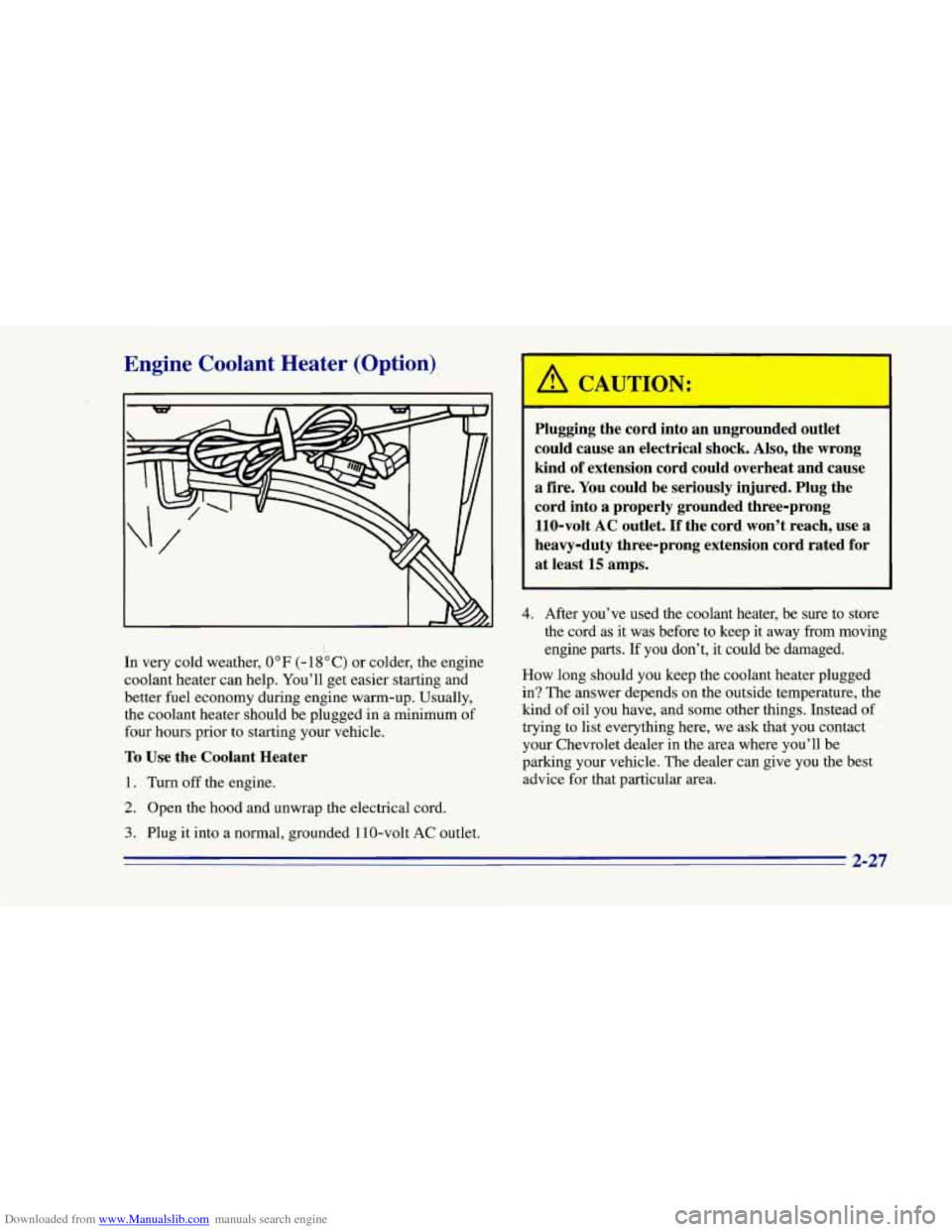
Downloaded from www.Manualslib.com manuals search engine Engine Coolant Heater (Option)
I
Plugging the cord into an ungrounded outlet
could cause an electrical shock. Also, the wrong
kind of extension cord could overheat and cause
a fire. You could be seriously injured. Plug the
cord into a properly grounded three-prong
110-volt AC outlet.
If the cord won’t reach, use a
heavy-duty three-prong extension cord rated for
at least
15 amps.
In very cold weather, 0°F (- 18 O C) or colder, the engine
coolant heater can help. You’ll get easier starting and
better fuel economy during engine warm-up. Usually,
the coolant heater should be plugged in a minimum
of
four hours prior to starting your vehicle.
To Use the Coolant Heater
1. Turn off the engine.
2. Open the hood and unwrap the electrical cord.
3. Plug it into a normal, grounded 1 10-volt AC outlet.
4. After you’ve used the coolant heater, be sure to store
the cord as it was before to keep it away from moving
engine parts.
If you don’t, it could be damaged.
How long should you keep
the coolant heater plugged
in? The answer depends on the outside temperature, the
kind
of oil you have, and some other things. Instead of
trying to list everything here, we ask that you contact
your Chevrolet dealer in the area where you’ll be
parking your vehicle. The dealer can give you the best
advice for that particular area.
2-27
Page 85 of 402
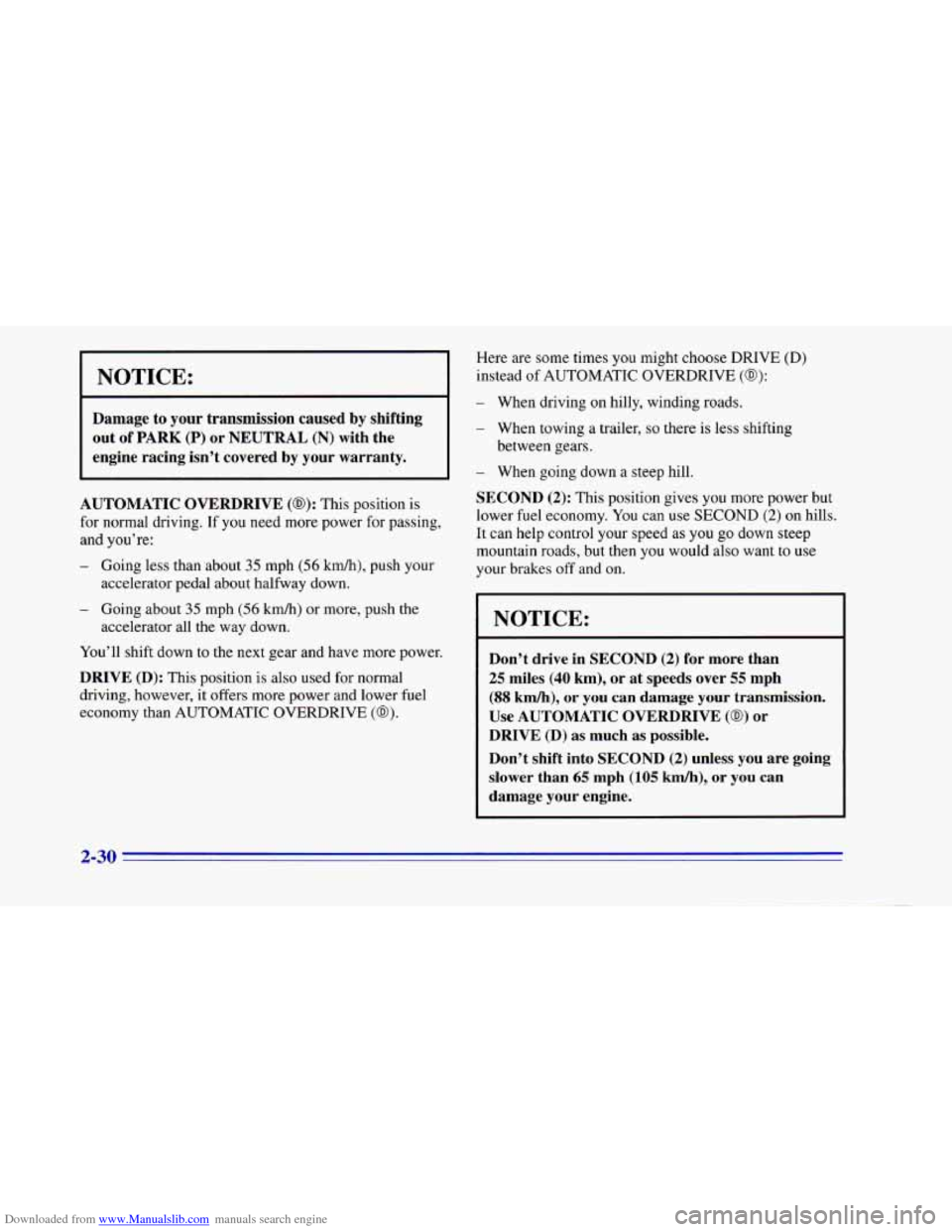
Downloaded from www.Manualslib.com manuals search engine I NOTICE:
Damage to your transmission caused by shifting
out of PARK
(P) or NEUTRAL (N) with the
engine racing isn’t covered by your warranty.
AUTOMATIC OVERDRIVE
(0): This position is
for normal driving. If you need more power for passing,
and you’re:
- Going less than about 35 mph (56 km/h), push your
- Going about 35 mph (56 kmh) or more, push the
accelerator pedal
about halfway down.
accelerator all the way down.
You’ll shift down
to the next gear and have more power.
DRIVE (D): This position is also used for normal
driving, however, it offers more power and lower
fuel
economy than AUTOMATIC OVERDRIVE (@).
Here are some times you might choose DRIVE (D)
instead of
AUTOMATIC OVERDRIVE (@):
- When driving on hilly, winding roads.
- When towing a trailer, so there is less shifting
between gears.
- When going down a steep hill.
SECOND (2): This position gives you more power but
lower
fuel economy. You can use SECOND (2) on hills.
It can help control your speed as you go down steep
mountain roads, but then
you would also want to use
your brakes
off and on.
I NOTICE:
~ Don’t drive in SECOND (2) for more than
~ 25 miles (40 km), or at speeds over 55 mph
~ (88 km/h), or you can damage your transmission.
~ Use AUTOMATIC OVERDRIVE (@) or
1 DRIVE (D) as much as possible.
’ Don’t shift into SECOND (2) unless you are going
slower than
65 mph (105 km/h), or you can
damage your engine.
I
2-30
Page 86 of 402
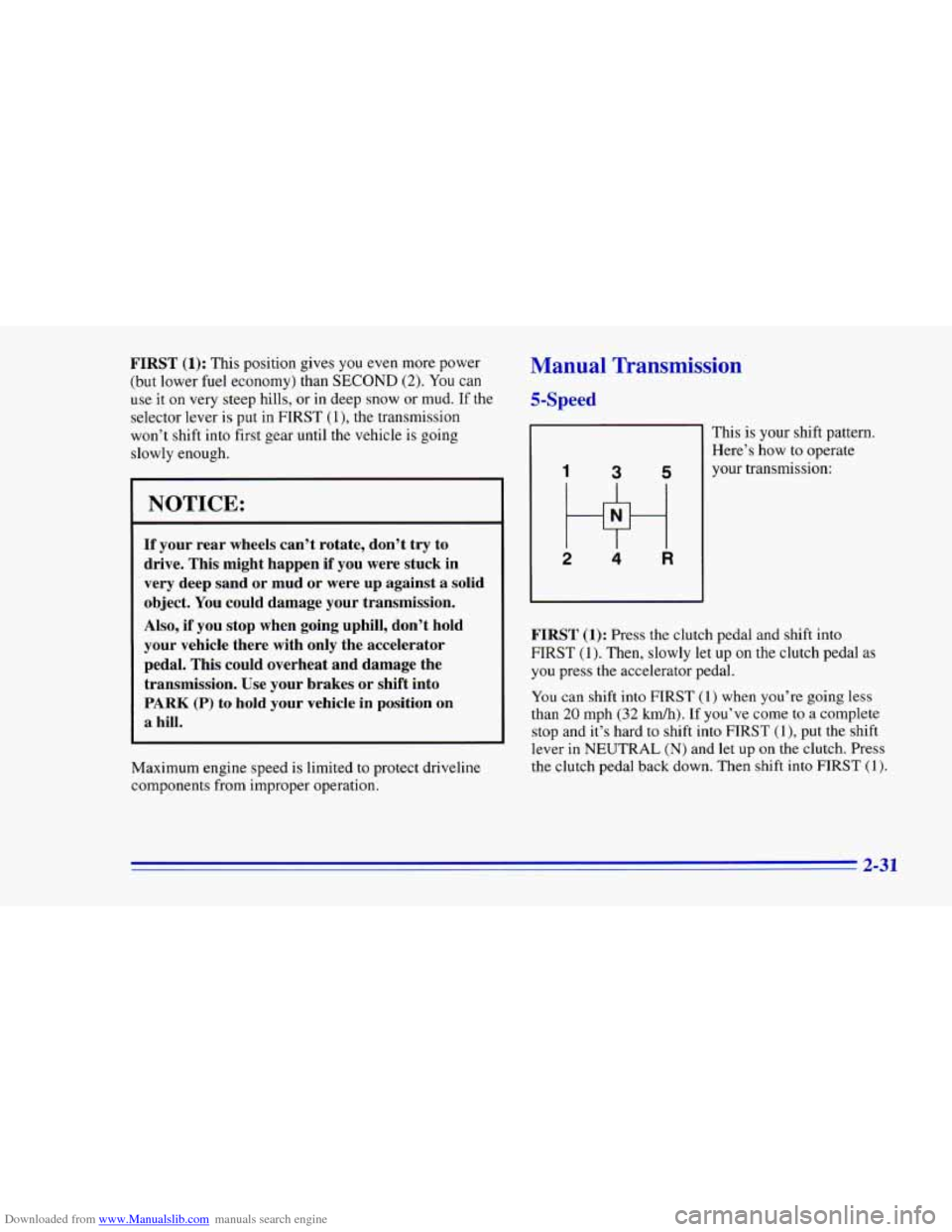
Downloaded from www.Manualslib.com manuals search engine FIRST (1): This position gives you even more power
(but lower fuel economy) than
SECOND (2). You can
use it on very steep hills, or in deep snow
or mud. If the
selector lever
is put in FIRST (l), the transmission
won’t shift into first gear until the vehicle is going
slowly enough.
NOTICE:
If your rear wheels can’t rotate, don’t try to
drive. This might happen if you were stuck
in
very deep sand or mud or were up against a solid
object.
You could damage your transmission.
Also, if you stop when going uphill, don’t hold
your vehicle there with only the accelerator
pedal. This could overheat and damage the
transmission. Use your brakes or shift into
PARK (P) to hold your vehicle in position on
a hill.
Maximum engine speed is limited to protect driveline
components from improper operation.
Manual Transmission
5-Speed
1 3 5
2 4 R
This is your shift pattern.
Here’s how
to operate
your transmission:
FIRST (1): Press the clutch pedal and shift into
FIRST (1). Then, slowly let up on the clutch pedal as
you press
the accelerator pedal.
You can shift into FIRST (I ) when you’re going less
than
20 mph (32 km/h). If you’ve come to a complete
stop and it’s hard to shift into FIRST
(I), put the shift
lever in
NEUTRAL (N) and let up on the clutch. Press
the clutch pedal back down. Then shift
into FIRST (1).
Page 89 of 402
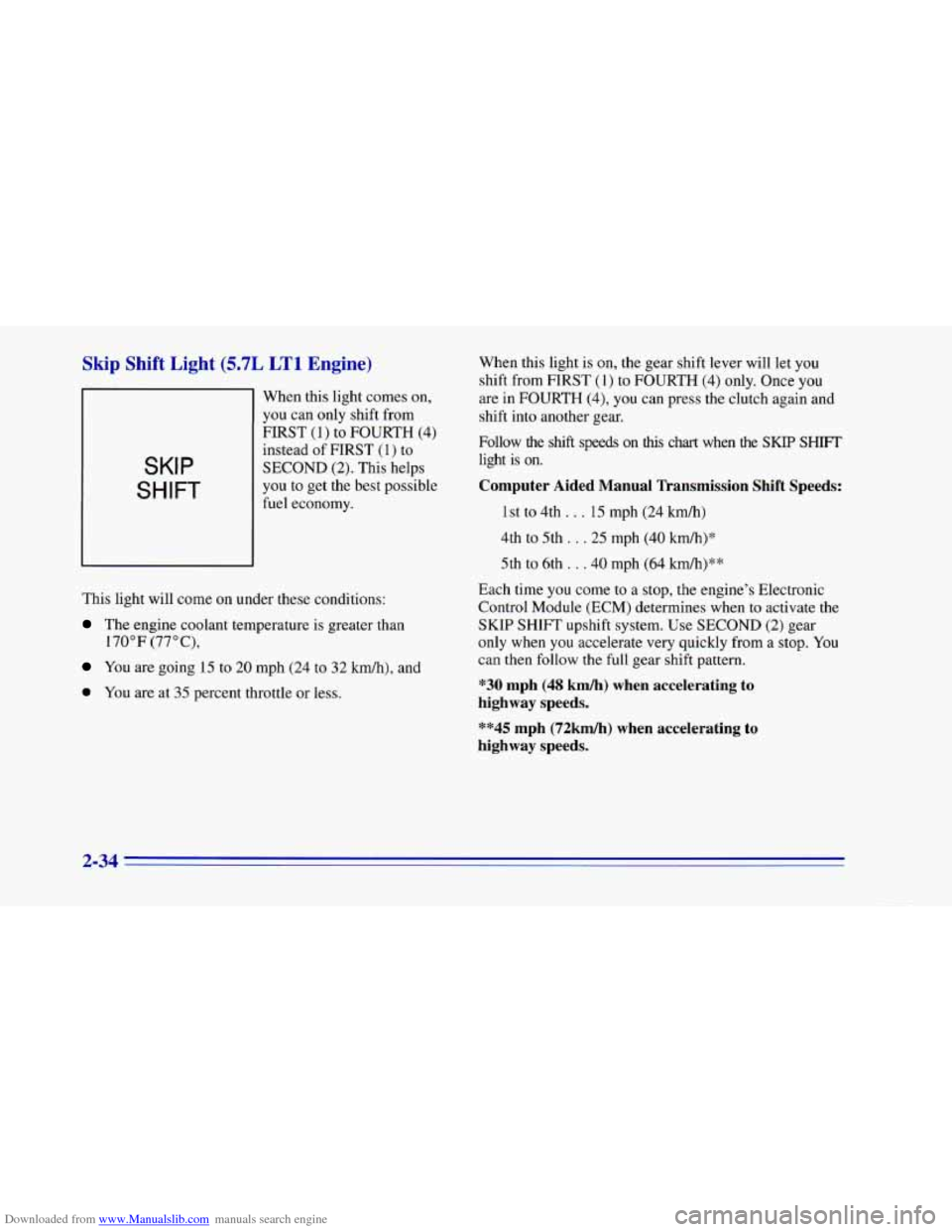
Downloaded from www.Manualslib.com manuals search engine Skip Shift Light (5.7L LT1 Engine)
SKIP
SHIFT
When this light comes on,
you can only shift from
FIRST
(1) to FOURTH (4)
instead of FIRST (1) to
SECOND (2). This helps
you to get the best possible
fuel economy.
This light will come on under these conditions:
The engine coolant temperature is greater than
170°F (77"C),
You are going 15 to 20 mph (24 to 32 km/h), and
0 You are at 35 percent throttle or less.
When this light is on, the gear shift lever will let you
shift from FIRST
(1) to FOURTH (4) only. Once you
are in
FOURTH (4), you can press the clutch again and
shift into another gear.
Follow the
shift speeds on this chart when the SKIP SHIFT
light is on.
Computer Aided Manual Transmission Shift Speeds:
1st to 4th. . . 15 mph (24 km/h)
4th to
5th . . . 25 mph (40 km/h)*
5th to
6th . . .40 mph (64 km/h)**
Each time you come
to a stop, the engine's Electronic
Control Module (ECM) determines when
to activate the
SKIP SHIFT upshift system. Use SECOND (2) gear
only when
you accelerate very quickly from a stop. You
can then follow the full gear shift pattern.
*30 mph (48 km/h) when accelerating to
highway speeds.
**45 mph (72kmh) when accelerating to
highway speeds.
2-34
Page 90 of 402
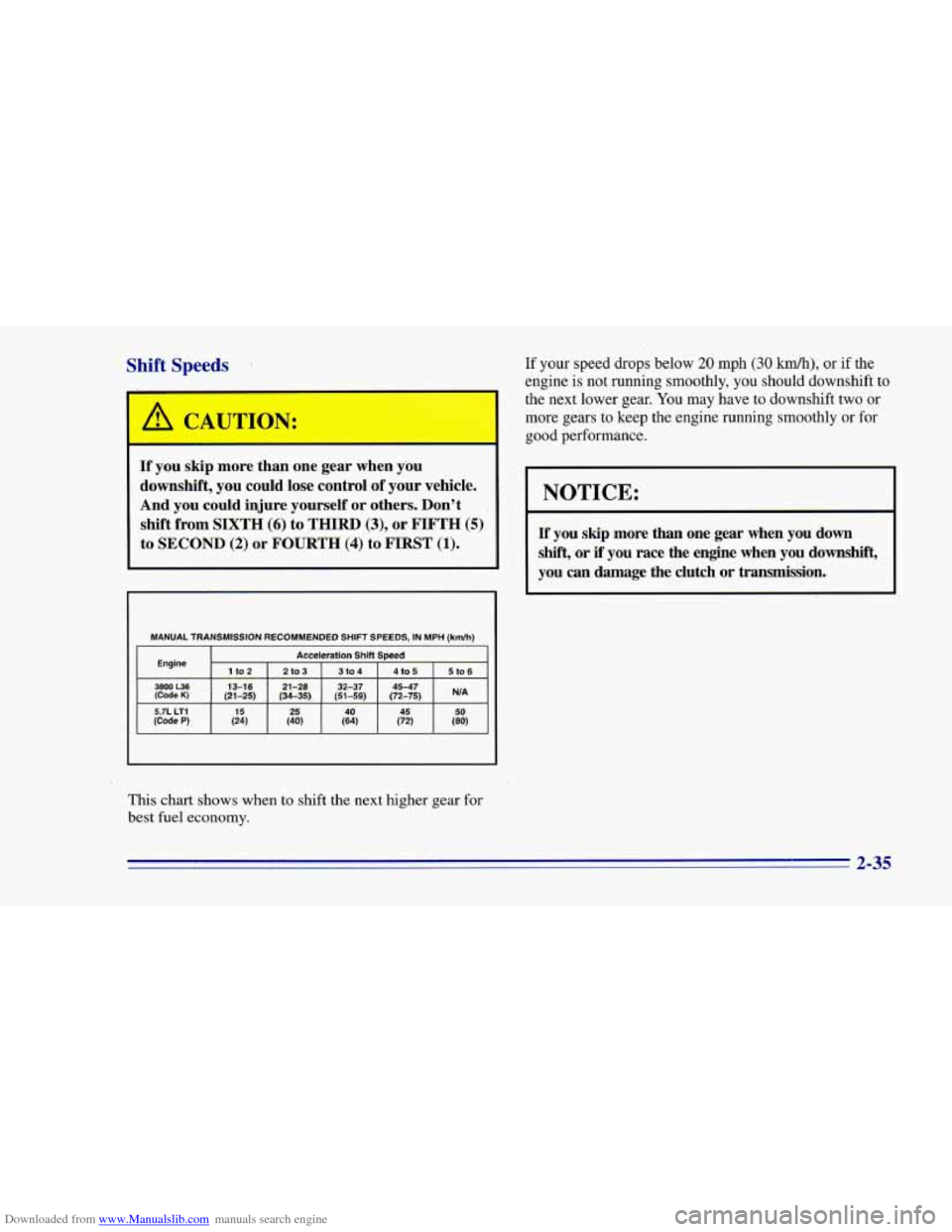
Downloaded from www.Manualslib.com manuals search engine Shift Speeds
If you skip more than one gear when you
downshift, you could lose control of your vehicle.
And you could injure yourself or others. Don’t
shift from SIXTH
(6) to THIRD (3), or FIFTH (5
to SECOND (2) or FOURTH (4) to FIRST (1).
MANUAL TRANSMISSION RECOMMENDED SHIFT SPEEDS, IN MPH (kmlh)
Acceleration Shif Engine
3800 W6 13-1 6 21 -28 32-37 (Code K)
i
ipeed
* (72-75)
This chart shows when to shift the next higher gear for
best fuel
economy.
If your speed drops below 20 mph (30 km/h), or if the
engine is
not running smoothly, you should downshift to
the next lower gear.
You may have to downshift two or
more gears to keep the engine running smoothly or for
good performance.
I NOTICE:
If you skip more than one gear when you down
shift, or if you race the engine when you downshift,
you can damage the clutch or transmission.
2-35
Page 129 of 402
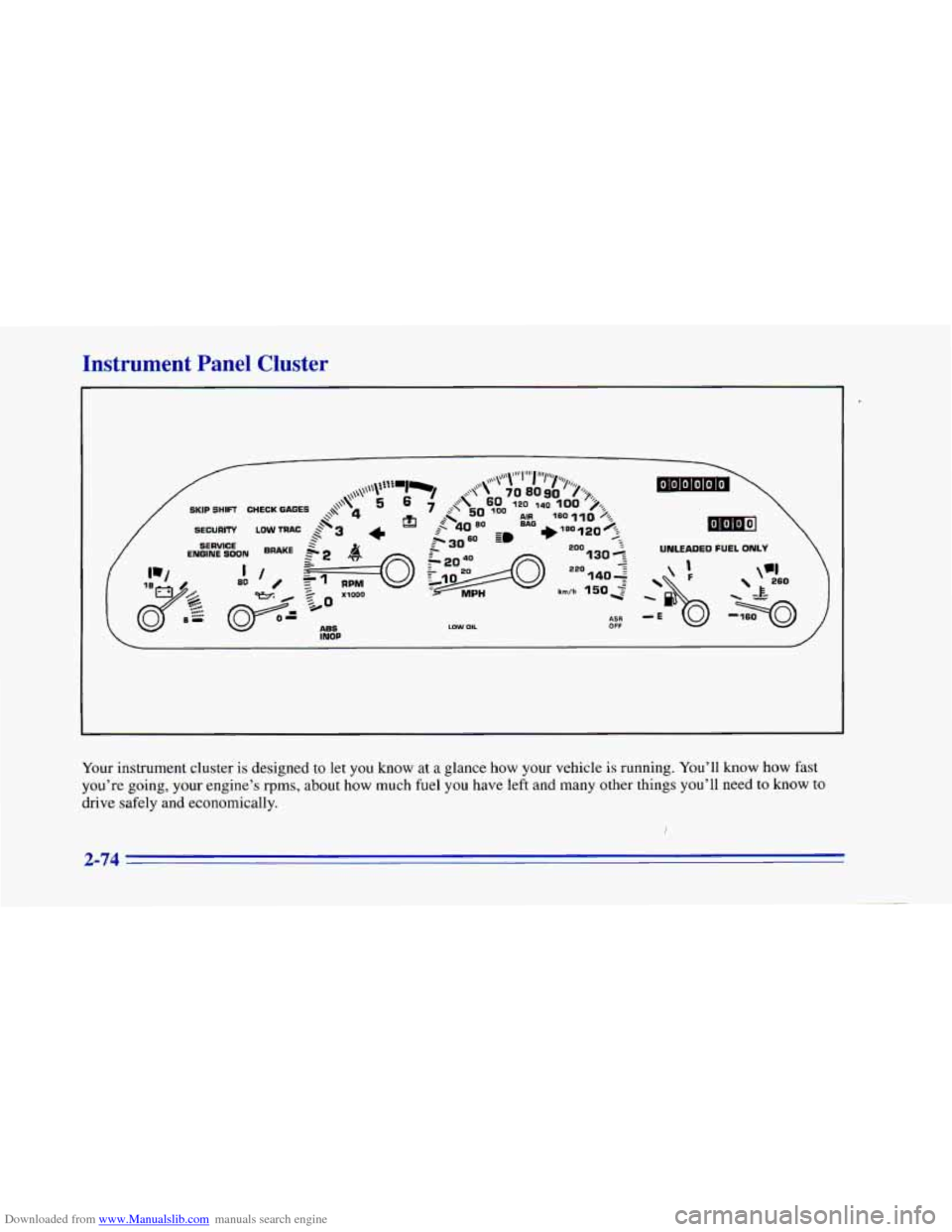
Downloaded from www.Manualslib.com manuals search engine Instrument Panel Cluster
Your instrument cluster is designed to let you know at a glance how your vehicle is running. You’ll know how fast
you’re
going, your engine’s rpms, about how much fuel you have left and many other things you’ll need to know to
drive safely and economically.
t
2-74